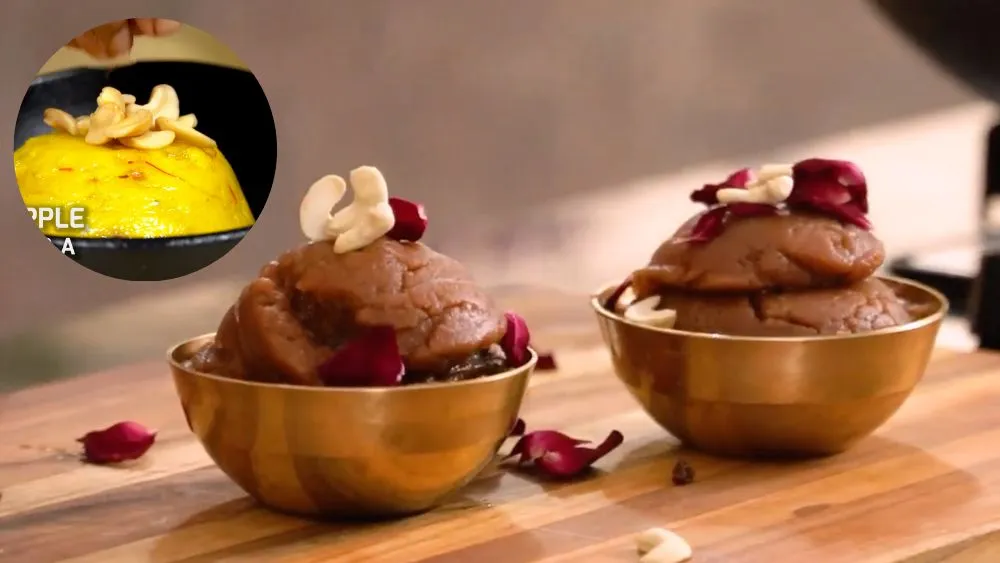
Aate ka halwa Recipe

35 mins

4-5 servings

15 mins
Introduction
Hey there, food lovers! Today, I'm excited to share with you a recipe that holds a special place in my heart - Aate ka Halwa. This delightful treat, also known as Kada Prasad, is more than just a dessert; it's a symbol of love and tradition. I vividly remember the first time I tasted Aate ka Halwa during a visit to a Gurudwara. The warmth of the prasad, infused with the aroma of ghee and roasted wheat flour, left an indelible mark on my taste buds.
Recipe of Aate ka Halwa
Ingredients:
- 1 cup Wheat Flour
- 1 cup Ghee
- 1 cup Sugar Syrup
Method:
- Heat a kadhai and add ghee. Allow it to melt.
- Add wheat flour in the same quantity as ghee and roast it on a slow flame until it becomes golden brown.
- Once the wheat flour turns golden brown, add the sugar syrup in the same quantity.
- Cook the mixture until the syrup is fully absorbed and the halwa starts leaving the sides of the kadhai.
- Serve the halwa hot, garnished with nuts of your preference.
For Sugar Syrup:
- In a pan, add 1 cup of sugar and 1/2 cup of water.
- Bring it to a boil and then simmer for 8 to 10 minutes until it becomes a sugar syrup.
Recipe of Pineapple Sheera
Ingredients:
- 3-4 tsp Ghee
- 1 cup Semolina
- 2-3 tsp Almonds
- 2-2 tsp Cashew Nuts
- 1 cup Sugar Syrup
- 1 cup Chopped Pineapple
- 1 cup Pineapple Puree
- 1/2 tsp Saffron
Method:
- Heat some ghee in a pot or pan, then add semolina and roast it until slightly golden brown.
- Remove the roasted semolina in a bowl.
- In the same pan, add 2 tsp ghee and roast some almonds and cashew nuts until golden brown. Then add the roasted semolina to it.
- Now add the sugar syrup, chopped pineapple, and pineapple puree to the pan. Mix well.
- Add saffron to give it a nice color and flavor and let it cook.
- Cook until its color becomes bright yellow or saffron.
- Serve it hot or cold according to your preference.
Enjoy these delicious Indian desserts with your loved ones!
About the Recipe
Aate ka Halwa, also known as Kada Prasad, is a traditional Indian dessert made from whole wheat flour, ghee, sugar, and water. Originating from Punjab, this sweet delicacy is often prepared during religious ceremonies and festivals as an offering to the divine.
To make Aate ka Halwa, whole wheat flour is roasted in ghee until golden brown, imparting a rich nutty flavor to the dish. The addition of sugar syrup lends sweetness and moisture to the halwa, creating a soft and crumbly texture that melts in the mouth.
Aate ka Halwa holds a special significance in Sikh culture, where it is served as prasad in Gurudwaras during langar, a communal meal. The act of preparing and sharing Aate ka Halwa symbolizes humility, equality, and selfless service, making it more than just a dessert but a sacred offering filled with love and devotion.
Cooking Tips
1. Roasting the Wheat Flour: Take your time to roast the wheat flour in ghee over low heat until it turns golden brown to achieve the perfect flavor and texture.
2. Sugar Syrup Consistency: Ensure that the sugar syrup reaches a one-string consistency to provide the right amount of sweetness and moisture to the halwa.
3. Use Quality Ingredients: Opt for high-quality whole wheat flour, ghee, and sugar to enhance the flavor and authenticity of the halwa.
4. Garnish with Nuts: Add a generous sprinkle of chopped nuts such as almonds and cashews for added texture and visual appeal.
5. Serve Warm: Aate ka Halwa tastes best when served warm, straight from the pan, for a comforting and indulgent experience.
Pairing Guide
Aate ka Halwa pairs beautifully with a piping hot cup of masala chai or creamy vanilla ice cream for a delightful contrast of flavors and temperatures. Enjoy it as a standalone dessert or as a sweet ending to a hearty meal.
Frequently Asked Questions about Aate ka Halwa
1. What is Aate ka Halwa? Aate ka Halwa, also known as Kada Prasad, is a traditional Indian dessert made from whole wheat flour, ghee, sugar, and water. It holds a special significance in Sikh culture and is often served as prasad in Gurudwaras during langar.
2. How is Aate ka Halwa prepared? To prepare Aate ka Halwa, whole wheat flour is roasted in ghee until golden brown, then cooked with sugar syrup until it reaches a soft and crumbly texture.
3. What is the significance of Aate ka Halwa in Sikh culture? Aate ka Halwa is considered a sacred offering in Sikh culture and is served as prasad in Gurudwaras during langar. It symbolizes humility, equality, and selfless service.
4. Can Aate ka Halwa be made without ghee? While ghee adds richness and flavor to Aate ka Halwa, it can be substituted with other cooking oils for a lighter version of the dish.
5. How long does Aate ka Halwa stay fresh? Aate ka Halwa can be stored in an airtight container at room temperature for up to 2 days or refrigerated for up to a week. Reheat before serving for the best taste and texture.
6. Can I add nuts and dried fruits to Aate ka Halwa? Yes, chopped nuts such as almonds and cashews, as well as dried fruits like raisins, can be added to Aate ka Halwa for added flavor and texture.
7. Is Aate ka Halwa gluten-free? No, Aate ka Halwa is made from whole wheat flour and is not gluten-free. It contains gluten, which may not be suitable for individuals with gluten intolerance or celiac disease.
8. Can Aate ka Halwa be made with jaggery instead of sugar? Yes, Aate ka Halwa can be made with jaggery instead of sugar for a slightly different flavor profile. Simply substitute an equal amount of jaggery for the sugar in the recipe.
9. Can I make Aate ka Halwa in advance? Yes, Aate ka Halwa can be made in advance and stored in the refrigerator for up to a week. Reheat before serving for the best taste and texture.
10. What are some variations of Aate ka Halwa? Some variations of Aate ka Halwa include adding mashed bananas, grated coconut, or flavored syrups like rose or saffron for a unique twist on the traditional recipe.
